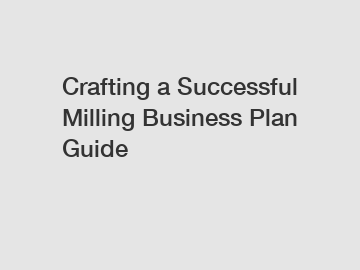Crafting a Successful Milling Business Plan Guide.
So you've decided to start a milling business - that's great! But before you jump right in, it's important to have a solid business plan in place. A well-crafted business plan will not only help you get organized and stay on track, but it will also be crucial in securing funding and attracting partners or investors. In this article, we'll walk you through the key steps to crafting a successful milling business plan.
1. Start with a Clear Vision.

The first step in creating a successful milling business plan is to have a clear vision of what you want to achieve. Do you want to focus on a specific type of milling, such as wheat or rice? Do you have a target market in mind, such as bakeries or restaurants? Having a clear vision will help you make informed decisions and set achievable goals for your business.
2. Identify Your Target Market.
Next, you need to identify your target market. Who are your potential customers? What are their needs and preferences? Understanding your target market will help you tailor your products and services to meet their specific requirements and stand out from the competition.
3. Conduct Market Research.
Once you have identified your target market, it's important to conduct thorough market research. This will help you understand the demand for milling services in your area, assess the competition, and identify potential suppliers. Market research will also help you determine pricing strategies and marketing tactics to attract customers.
4. Develop a Marketing Strategy.
A strong marketing strategy is essential for the success of your milling business. This should include a detailed plan for promoting your products and services, reaching out to potential customers, and building brand awareness. Consider using a mix of online and offline marketing channels to reach a wider audience.
5. Create a Financial Plan.
Your financial plan is a crucial component of your milling business plan. This should outline your startup costs, operating expenses, revenue projections, and cash flow forecasts. It's important to be realistic and conservative in your financial projections to ensure the long-term sustainability of your business.
6. Seek Funding and Partnerships.
Once you have a solid business plan in place, it's time to seek funding and partnerships to help you get your milling business off the ground. Consider reaching out to investors, financial institutions, or government programs that support small businesses. Building strong relationships with suppliers and other industry partners can also help you secure the resources and support you need.
Crafting a successful milling business plan may seem like a daunting task, but with the right guidance and information, you can set yourself up for success. By starting with a clear vision, identifying your target market, conducting market research, developing a marketing strategy, creating a financial plan, and seeking funding and partnerships, you'll be well on your way to building a thriving milling business. Remember, if you have any questions or need assistance along the way, don't hesitate to contact us or reach out to a trusted supplier for support. Good luck on your milling business journey!
If you are looking for more details, kindly visit wheat flour processing plant, wheat flouring machine, maize milling machine for india.



Comments
All Comments (0)